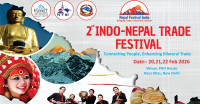Money
Rising dollar makes winter clothes more expensive
Prices of clothes and footwear rose by 7.68 percent in the first two months of this fiscal year, the central bank said.
Krishana Prasain
Winter clothes have become exorbitantly expensive due to a strong dollar, high transportation costs and low supply from China, according to traders.
Nepali merchants say they haven't seen prices rise so steeply before. As per Chandan Pathak, proprietor of Voss Apparels, a men’s clothing store on New Road, the price of each item has increased by Rs500 to Rs1,000.
Down jackets, long coats and fleece jackets have become pricier.
"Even the price of the humble thermocot has risen to Rs1,800-2,000 from Rs1,200-1,400 last year," said Pathak.
He gets his stock from China, and says that higher customs duties and freight charges are responsible for the price increases.
“Clothing items that come by air cargo are costlier than those that come overland,” said Pathak. “Even Nepal-made brands are expensive.”
According to Nepal Rastra Bank, prices of clothes and footwear rose by 7.68 percent in the first two months of the current fiscal year ended mid-September.
The figure was 3.41 percent in the same period in the last fiscal year.
Consumer price inflation stood at 8.64 percent in the review period as compared to 3.49 percent a year ago. Food and beverage inflation was recorded at 8.17 percent, while non-food and service inflation reached 9.02 percent, the central bank report said.
Transport inflation jumped by 23.41 percent in the first two months of the current fiscal year, compared to 9.92 percent in the same period in the last fiscal year.
Sunil Kumar Dhanuka, immediate past president of the Nepal Foreign Trade Association, said that imports had declined by 35-40 percent, mainly due to the appreciation of the dollar that has made goods very expensive.
“The government rule requiring importers to keep 100 percent margin amount to open a letter of credit, a measure intended to control imports, has also increased prices of goods.”
Last December, the central bank made it mandatory for importers to keep 100 percent margin to open a letter of credit for the import of alcoholic drinks, tobacco, silver, furniture, sugar and foods that contain sweets, glucose, mineral water, energy drinks, cosmetics, shampoos, hair oils and colours, caps, footwear, umbrellas and construction materials.
"Freight charges have declined slightly of late, but they have nothing to do with the costs," said Dhanuka.
It costs $4,500-$5,000 to ship a 40-foot container from China to Nepal and $2,500-$3,000 to ship a 20-foot container.
"The fee to ship a 20-foot container had once reached $5,500. The cost of shipping a 40-foot container had gone up to $9,000-$9,500," Dhanuka said.
Before the pandemic, the charges were $1,800-$2,000 for a 20-foot container and $2,800 for a 40-foot container.
According to international media reports, freight rates have continued to fall as global trade volumes slowed as a result of shrinking demand for goods.
While freight rates have also fallen due to the easing in supply chain disruptions built up over the pandemic, a lot of the slowdown in container and vessel demand was due to weaker cargo movement, according to reports.
Naresh Katuwal, immediate past president of the Nepal National Traders' Federation, said there were many factors behind the rise in the price of winter clothes in the domestic market.
The cost of importing goods has increased by 15 percent from last year.
Transport costs have more than doubled. The bank interest has reached almost 18 percent, nearly twice last year’s level.
Traders say that banks have stopped issuing loans, and now cooperatives too are turning away borrowers.
"However, rents and worker salaries are increasing," said Katuwal. “Businesses in Nepal are suffering from multitudes of problems.”
Last Friday, members of the business community took to the streets to protest the high interest rates charged by banks and financial institutions.
Demonstrators associated with the Kathmandu, Bhaktapur and Lalitpur chapters of the Federation of Nepalese Chambers of Commerce and Industry, Nepal Wool Felt Producers' and Exporters' Association and Woollen Felt Producers and Exporters Association, among others, staged a sit-in at Maitighar Mandala in Kathmandu, claiming that banks and financial institutions were charging exorbitant interest rates.
Businessmen say they have been hit hard as banks have increased the interest rate three times in the past year. Banks, for their part, have defended the move saying rising interest rates are a global phenomenon.
As traders have been rerouting shipments because of the hassle of bringing goods overland from China across the northern border, costs have doubled, insiders said.
"It takes two-three months for goods coming through Indian seaports to reach Nepal," Katuwal said.
“Traders now have trust issues with the Tatopani and Kerung border points as they can slam shut anytime. Importers have been ordering fewer goods from the Kerung border. All these reasons are linked with the rise in prices in the market,” Katuwal said.
According to the Department of Customs, imports of apparels and clothing accessories fell by 27.78 percent to Rs7.60 billion in the first three months of the current fiscal year ended mid-October.
Nepal imported apparels and clothing accessories valued at Rs32.98 billion in the last fiscal year.
Amit Lama, co-founder of apparel maker Doro Wears, said the company had been importing almost 95 percent of its raw materials from China.
“But as the raw materials are not arriving regularly as per demand, prices of winter clothes have gone up in the domestic market.”
Prices of each item of winter clothes in the domestic market have increased by Rs200 to Rs600, said Lama, whose company produces fleece jackets, windcheaters, hoodies and joggers, among other winter wear.
“Prices would be lower if the raw materials arrived on time,” he said. Lama said that sales had also decreased due to inflation.
“Sales have fallen. The cost of production has gone up steeply. It is getting difficult to survive in this business.”




 7.15°C Kathmandu
7.15°C Kathmandu













%20(1).jpg&w=300&height=200)
